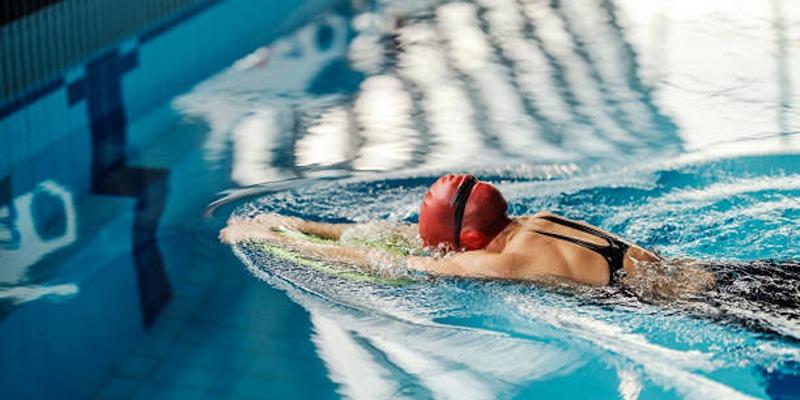Indeed, swimming and running are some of the best-known types of cardiovascular exercises, which not only have an increasingly positive disposition from the general public but are also easily accessible. However, different types of exercises have their own advantages and disadvantages, which might suit your desired fitness, health status, and lifestyle. Now that we have the overall dimensions established, lets take a closer look at each type to make things somewhat easier on you!
Benefits of Swimming
 Swimming is a good form of exercise since it does not pose any effects on the joints of the body. Here are some of the key advantages:
Swimming is a good form of exercise since it does not pose any effects on the joints of the body. Here are some of the key advantages:
Full-Body Workout
Swimming activates the muscles of the body in a group fashion. Your arms, legs, core, and back come into play when swimming Its low-impact while helping you build the muscles of your upper and lower body. This makes it an ideal solution for anyone who would want to build muscle tone and strength around their body but not a specific part of it.
Low-impact, Joint-Friendly Exercise
Swimming is particularly suitable for folks with arthritis, joint pain, or injury because the water takes the pressure off the joints and bones. It is particularly preferred by people that have sensitive muscles but want a rigorous exercise without having to strain themselves.
Improved Lung Capacity and Cardiovascular Health
Swimming requires controlled breathing and endurance, which can lead to improved lung capacity and overall cardiovascular health. The rhythmic breathing pattern in swimming exercises the respiratory system, potentially leading to better breathing efficiency even outside of the water.
Increased Caloric Burn in a Short Time
Swimming can burn a high number of calories quickly, especially if youre practicing challenging strokes like butterfly or freestyle at a high intensity. As a result, swimming is a good option for those who want a calorie-torching workout.
Benefits of Running
Running, on the other hand, is one of the most accessible forms of exercise. Heres why many people choose it:
High-Calorie Burn and Weight Loss
It is a high-intensity exercise whereby many people who run in an attempt to lose some weight will be happy to know that running burns the most calories per given minute. The kind of running possible depends on the frequency and duration of the exercise; it can be a slow jog or a faster jog, interval training or the like; this makes a person burn a lot of calories thus bringing about weight loss.
Convenience and Accessibility
Running requires little preparation a decent pair of shoes and a piece of open land. This makes it one of the most exercise friendly, especially for those who may be working, studying or even on a business trip. Running is not the same as swimming because running can take place anywhere, from a treadmill, around the track, or even on your street.
Strengthens Bones and Muscles
The other important benefit of running is that it is a weight bearing exercise that can help to build bones and increase muscle mass taking time into consideration. This might be useful for bone health over time and can even help delay osteoporosis in later years.
Mood Enhancement and Mental Health
Running is known to release endorphins, the feel-good hormones that can improve mood and reduce stress. This phenomenon, often called a runners high, can also help combat symptoms of anxiety and depression, giving runners both physical and mental health benefits.
Drawbacks of Swimming
Though swimming is beneficial, it may have some limitations depending on your personal needs.
Limited Accessibility and Weather Dependency
People do not go swimming from stairs to stairs and not every house is near a pool; thus, swimming often needs controlled surroundings. Some people may use pools during some times of the year, which can make it hard for users to get to the pools frequently.
Learning Curve for Beginners
While running comes naturally to most people swimming on the other hand requires skill and technique. For those who arent comfortable in the water, you might need to take lessons or hang in the pool to build your experience within the gym safely.
Drawbacks of Running
 While running has many advantages, its not without its challenges.
While running has many advantages, its not without its challenges.
High-Impact on Joints
Running can place a lot of stress on the knees, ankles, and hips, which may lead to injuries over time. Those with joint issues or past injuries might find running too hard on their bodies, particularly on hard surfaces.
Weather and Terrain Constraints
Although running is highly accessible, bad weather can limit outdoor runs. Extreme temperatures or rainy days may push runners indoors, where a treadmill might feel less exciting.
Risk of Overuse Injuries
Running, especially for long distances or frequent sessions, can lead to overuse injuries. These might include shin splints, tendonitis, or stress fractures, which can be painful and require time off for recovery.
Comparing Swimming and Running in Key Areas
When comparing swimming and running, consider factors like accessibility, impact on joints, and overall calorie burn. Swimming provides a low-impact, joint-friendly workout, while running offers high-calorie burn and convenience.
Calorie Burn and Weight Loss Potential
Swimming as well as running is useful for calorie usage, the latter extra useful due to the higher calories per minute rate. Nevertheless, swimming is a total body exercise and may prove more effective in toning muscles apart from helping you shed those extra calories. The quick reduction of your weight accounts for the fact that running may be slightly better for you if that is your top priority, whereas swimming is more of a well-rounded way of losing weight while toning your muscles at the same time.
Cardiovascular Health
Both activities are excellent for cardiovascular health, but they train your body differently. Swimming requires controlled breathing and can improve lung capacity, while running focuses on endurance and can enhance heart strength and stamina over time. Either choice benefits your cardiovascular system, but swimming may offer a slight edge in lung health.
Muscle Development
Swimming engages the upper and lower body, making it ideal for balanced muscle development. Running, while primarily working the lower body, builds endurance and muscle strength in the legs. If youre looking for overall muscle toning, swimming may be a better option, while running is excellent for strengthening the lower body.
Mental Health Benefits
Both exercises offer mental health benefits through the release of endorphins. However, swimmings rhythmic, repetitive motions can be meditative, reducing stress and enhancing focus. Running, with its potential for a runners high, provides an equally powerful mood boost. Choose based on the type of mental relaxation you seek water's calming effect or the exhilaration of a run.
Who Should Choose Swimming?
Swimming may be right for you if:
- Youre looking for a low-impact exercise thats gentle on your joints.
- You want a full-body workout that builds muscle and burns calories.
- You have access to a pool and enjoy water-based activities.
Who Should Choose Running?
Running may be better if:
- Youre seeking a high-calorie burn and are focused on weight loss.
- You enjoy the convenience of an exercise you can do almost anywhere.
- You dont have joint issues and prefer a high-intensity workout.
Conclusion
Choosing between swimming and running depends largely on your personal preferences, goals, and physical condition. Swimming provides a low-impact, full-body workout thats excellent for muscle toning and joint health. Running, on the other hand, offers high-intensity calorie burn and convenience, making it perfect for those focused on weight loss and endurance. Both exercises have immense health benefits, so consider what aligns best with your lifestyle and fitness goals. Remember, the best exercise is the one you enjoy and can stick to in the long run.







